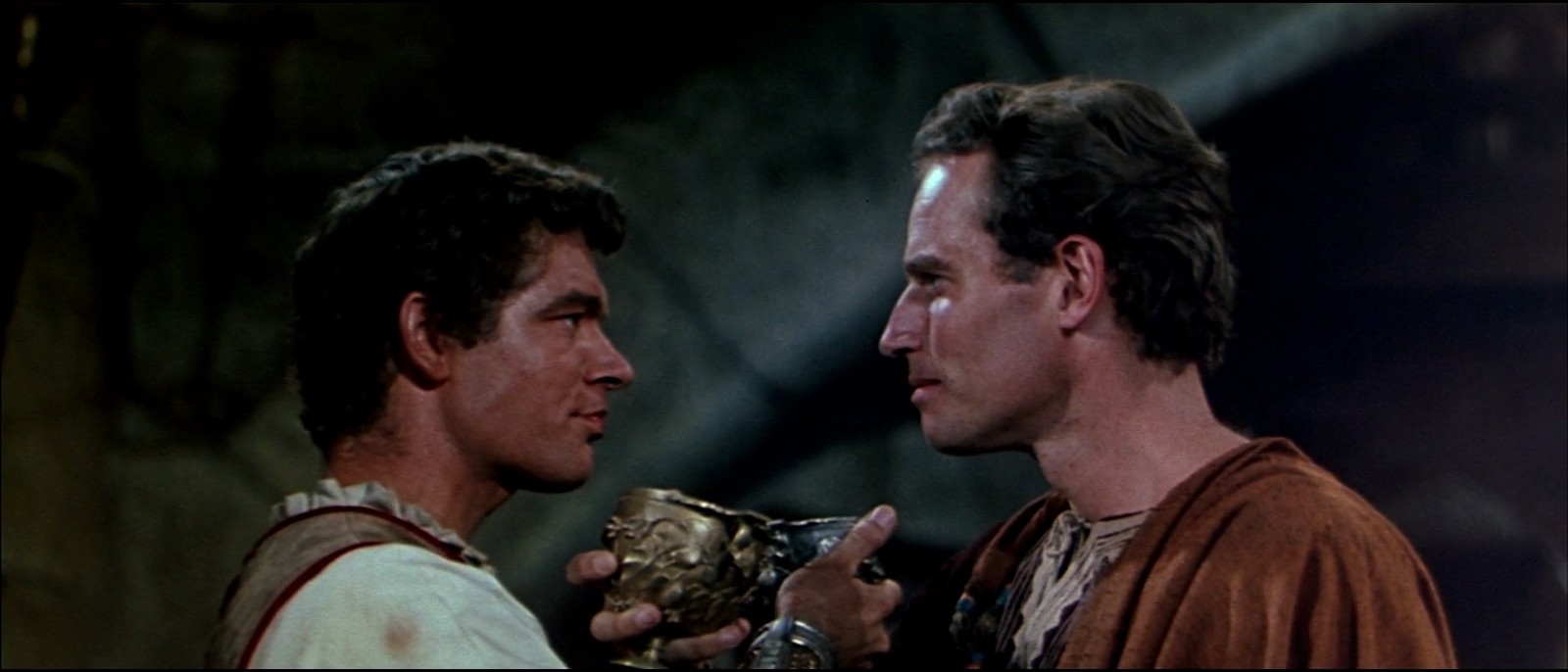Stephen Boyd and Charlton Heston in 'Ben Hur,' as seen in 'The Celluloid Closet'
★★★★★ | André Crous
Just like the people they portray, films with LGBT characters have always been around. In 1995, at the 100-year mark of the birth of cinema, an expansive documentary rounded up a century of (mostly, but not always, implicitly) homosexual or queer characters and narrative trends to show how, even in the darkest days of the moralistic Hollywood Production “Hays” Code, the closet door was often ajar.
Based on the exhaustive overview provided by Vito Russo’s 1981 landmark book of the same name, The Celluloid Closet was made by Rob Epstein and Jeffrey Friedman, two openly gay documentary filmmakers who had already won Academy Awards for tackling subjects close to LGBT viewers’ lives in The Times of Harvey Milk and Common Threads: Stories from the Quilt.
Their 1995 documentary features a treasure trove of film clips, as well as interviews with numerous industry professionals who talk about how they perceived certain movies while they were growing up, how they had to work within and around the Code and what the challenges were in producing an authentic representation of gay life. Among the best-known interviewees are playwright Armistead Maupin, actor-director Harvey Fierstein and writer-provocateur Quentin Crisp, with mainstream actors like Tom Hanks, Whoopi Goldberg and Susan Sarandon (all of whom portrayed gay characters during their careers) also contributing their impressions.
The opening clip crystallises the early years’ depiction of same-sex activity: In the 1934 film Wonder Bar, a man and woman are dancing at a ball when another man approaches to ask whether he can “cut in”. The woman moves towards him, assuming the request is directed towards her, only to be rebuffed when the two men grab each other’s hands and start dancing. A few steps behind them, singer Al Jolson’s eyes are big as plates. He throws a limp wrist into the air and exclaims, “Boys will be boys!”
But such tolerance, even if mocking or condescending in tone, was soon torpedoed by the Hays Code, which sought to clamp down on films’ generally permissive attitude with regard to sexuality – by then, big-name filmmakers like D.W. Griffith and Cecil B. DeMille had already made blockbuster films showing full-fledged (heterosexual) orgies. Starting in the early 1930s, the Code curtailed depictions of rape, abortion, sex perversion (i.e. any positive representation of LGBT life), prostitution, nudity, white slavery and the use of profanity, among others.
Thus, gay characters were driven into the background, their stories were made to look straight, or it was made clear that their lifestyle was abominable. And they were almost always killed off by the final act. But while some viewers were happy to see characters similar to themselves, the representation was terribly one-sided, even tragic.
For most of the 20th century, films consistently presented gay characters as outcasts who were to be made fun of, judged as degenerates or pitied for the miserable lives they lead. Generally speaking, the characters were trapped and unable or unwilling to effect change, which made them powerless and frequently led to them committing suicide or dying in various ways. In one eye-opening sequence, The Celluloid Closet shows us one death after another of these films’ gay characters: by gunshot, by stabbing, by hanging, by fire, by crossbow… even by having a tree fall on them.
Narrator Lily Tomlin correctly points out that “Hollywood, that great maker of myths, taught straight people what to think about gay people, and gay people what to think about themselves.” When all you see of gay life is a one-dimensional depiction of melancholy ending in tragedy, there is inevitably an effect on all viewers irrespective of their sexuality. Of course, there are people identifying as one or more of the letters in LGBT who are sad or suicidal, just like their straight counterparts, but representations need to reflect the diversity of real life, which only comes from telling more stories and treating all characters as full human beings with real agency.
But even when characters, especially those based on real-life individuals, were mostly stripped of their sexuality, traces remained. Perhaps it is because many filmmakers remained committed to reflecting real life. Or perhaps the reason is that, throughout the filmmaking process, some screenwriters were gay, some directors were gay, some actors and actresses were gay, and so on, and they wanted to include part of themselves and what they knew in the product they were creating.
This is a documentary that adds depth and nuance to characters and narratives we thought we knew. We see how affection between men – approached with surprising sensitivity – was often there if we looked a little more closely. An excerpt from Their First Mistake, in which Laurel and Hardy share a bed, help each other take care of a baby and confess their bond to each other, makes this plain for all to see. So, too, does a scene from Wings, the first-ever Best Picture Oscar winner, which features two men stroking each other’s hair, with one planting a kiss on the other’s lips.
Cabaret scribe Jay Presson Allen laments the fact that the 1950s were an era of such “towering dullness” because the stories being told were all terribly safe and uninspiring, but the ever-irreverent Gore Vidal lets us in on a juicy gay angle in the biblical epic Ben-Hur, released in 1959, which he had a hand in writing.
It is said that sunlight is the best of disinfectants. Films with LGBT characters or storylines provide sunlight by highlighting people and plots that are not as well-established as the decades of straight storylines, thus washing away the veneer of grime that had built up over decades of misrepresentation. And while this documentary certainly does not pretend that every classic film falls somewhere on the Kinsey scale, it does encourage us to examine them more critically and potentially to discover the rainbow in the black and white.
Although its focus is squarely on the U.S. film industry, The Celluloid Closet makes little mention of the broader historical context, namely that the advent of the modern gay rights movement (the 1969 Stonewall riots) coincided with the downfall of the dreadful Code, and that the subsequent AIDS crisis of the 1980s and early 1990s pushed LGBT stories out of the metaphorical closet and into the limelight.
It would be fascinating to see an updated account of LGBT representation in film, as a great deal has changed since 1995. The number of films built around gay characters who do not fold under pressure but stand up for themselves or, better yet, are simply part of a story other than their sexuality, has risen sharply over the past few years.
As witty and entertaining as it is informative, The Celluloid Closet remains the gold standard for information about and insight into the traces of homosexuality in films during the first 100 years of cinematic history. Over the ensuing quarter of a century, films like Brokeback Mountain, Milk, Blue is the Warmest Colour and Moonlight would all make a big splash on the global circuit. Myriad more, from those of Sebastián Lelio, João Pedro Rodrigues, Marco Berger and Kimberly Peirce to the ones of Dee Rees, Todd Haynes, Xavier Dolan and Pedro Almodóvar, have already given a firm indication that the next 100 years will produce an infinitely greater variety of movies than before – in whatever way their storytellers choose.
—
Country USA
Released 1973
Director(s) Rob Epstein, Jeffrey Friedman
Screenwriters Rob Epstein, Jeffrey Friedman
Directors of Photography Nancy Schreiber
Stars Whoopi Goldberg, Tom Hanks, Lily Tomli
Running Time 105 minutes
Genres Documentary
Original title
André Crous is a professional film critic and a member of FIPRESCI. He holds a French honour’s degree, two master’s degrees and a Ph.D. His research examined the works of Francois Truffaut, Mikhail Kalatazov, Martin Scorcese, Paul Thomas Anderson and Michael Winterbottom. He writes about movies in his blog, Celluloid Paradiso and lives in Prague, Czech Republic. | Read More ⟩



